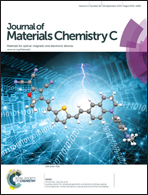Band gap control and transformation of monolayer-MoS2-based hetero-bilayers†
Abstract
The study of heterostructured bilayer systems is an essential prerequisite for developing two-dimensional nano-electronic devices. Using ab initio density functional theory calculations, we investigated the atomic and electronic properties of hetero-bilayers composed of silicene and germanene layers with the MoS2 monolayer. Our results show that both silicene–MoS2 and germanene–MoS2 hetero-bilayers are direct band gap semiconductors. The band gaps of silicene and germanene in hetero-bilayers are opened due to the sublattice symmetry breaking induced by the introduction of the MoS2 monolayer, indicating that the MoS2 monolayer makes a good complement to silicene and germanene. Moreover, tunable band gaps in silicene and germanene can be realized by changing the interlayer distance or employing in-plane compressing/stretching. Especially, through compressing or stretching, germanene–MoS2 bilayers realize a transformation from an indirect band gap semiconductor to a direct band gap semiconductor, while the silicene–MoS2 bilayers can retain the direct band gaps. Our results in this work provide a new method for designing MoS2-based nanodevices with controllable band gaps.


 Please wait while we load your content...
Please wait while we load your content...